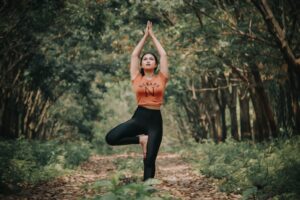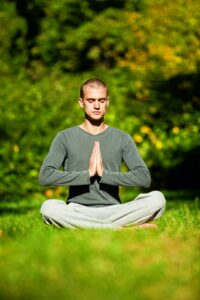“A gesture of light-heartedness” is how my yoga teacher describes vrksasana, or tree pose. We come into this balancing posture at the end of our standing sequence, having repeated postures like “sun salutations” and “warriors” that reinforce our confidence and clarity in being able to stand on our own feet. Tree pose, then, acts as a kind of capstone to that work, and a fulcrum as we pivot toward the calmer, softer conclusion to the practice, where we lie down on the floor again and prepare for the final rest, or corpse pose: savasana.
The physical challenge of standing on one leg for tree depends on a few things. But making the pose “light-hearted” is a challenge of its own order, because of how it rubs up against the attitude many people have toward balance—on and off the yoga mat. We think of balance as a state of being, something we can achieve and “hold” in absolute, perfect stillness. Social media perpetuates this association between yoga and an idealized life, as we ooh, ahh, and ❤️ whenever we see a photo of someone in a daredevil acrobatic shape, frozen in space.
But as with tree pose, any other balancing yoga posture, and life itself, believing we can “hold” balance is pure delusion. For anyone who’s done tree, you know that even on your best day, your standing foot is doing all sorts of work to hold you up on one leg. Besides those wobbles, your whole body is orchestrating a symphony of micro-adjustments internally for the duration of the pose, even if you can’t feel or see them. We can’t change the fact that what goes up must always come down, but we can adjust the energy of that trajectory with our mindset. If we clutch tightly onto the moment that’s ending, the loss will be huge; but if you hold gently, the essence of my teacher’s tree pose practice, you’ll suffer less and be better able to mindfully assume whatever pose comes next.

Balance as an Adaptive Continuum
Whether we’re trying to stand on one leg, figure out how to succeed at work and raise a family, or find that just-right amount of food or exercise, balance is elusive, and spending lots of energy trying to achieve it can be a trying endeavor. That doesn’t make it not worth experiencing, however. It just requires a bit of reframing—or, unframing, since the practice of balance doesn’t fit so neatly into most categories of experience we have in our rigid modern life.
Balance is not a fixed state, not something we can achieve or plan for. It’s an action, but not something we need to consciously make an effort to do. Rather, balance is a continuously adaptive continuum—the wave-particle, both-and-ness of our existence that we so often try to split into nouns and verbs, being and doing. Balance is who we are in our totality of light and shadow, activity and rest, doing and being, life and death. It defies time and yet is time, all of it, all at once. Balance takes into account everything that came before, what’s happening now and a sense of preparation for the future. It’s the encapsulation of an intelligent system that we might call our bodies or even our universe.
There’s no better proof than the nature of this ongoing holistic process, particularly in the seasonal equinoxes. While we might celebrate the equinox over one or several days as a pinnacle of ecological and astrological harmony, that perfectly equal amount of light and dark lasts for a mere instant before the scales start to tip toward the next extreme.
These shifts are subtle, gradual, continuous, and largely imperceptible to us humans—until suddenly we wake up or sit down to dinner under a darker sky. It’s that ability for the planet to always be turning toward and away from the sun that keeps us alive, and allows the ongoing regeneration of life in so many forms year to year. We might reflect on this fact when we come to our equinox rituals—not as a single moment in time to grasp onto, but as a sliver of the timeless story of our existence individually and together.
Balance as the Path to Longevity
Ayurveda has countless ways of treating health conditions from food and herbs to lifestyle and yoga postures. While every protocol is unique to the individual, the approach to healing is always the same: balance. There’s even a saying that goes “like increases like and opposites balance.” For instance, if you were experiencing acid reflux and piercing migraines, you might have an excess of the hot, sharp qualities of the pitta dosha. To balance that, you’d turn to things that are cooling and softening—the smell of rose or lavender, fennel, and mint tea, sweet fruit, or a dip in the pool (or under the full moon for a moon bath).
The definition of health from this perspective requires a constant checking in and recalibration of what qualities are needed to balance the qualities that are present. Depending on your state of health, the seasons, or your environment, what balances you will change. Micro-adjustments to what you eat, your activities, or how much sleep you get will ensure that your system doesn’t get overwhelmed by anyone or group of qualities.
We can feel this happening all on its own when the seasons shift. Think about how you might feel at the time of the fall equinox—dried out, irritated, and tired from the accumulation of heat all summer. If you did your work in balancing that heat with opposites all season, what you feel at the turn of the season won’t be so extreme. Even if you didn’t, spending time between seasons to gradually shift your routines into the next set of qualities—the dry, cold, mobile seasons of vata—you’ll sail through fall and winter without a problem. Do this every season—and every day—and you have the recipe for a long, healthy life.

Balance as Honoring Life
The balancing principles of Ayurveda may be geared toward longevity first and foremost, but they’re equally useful for helping us confront and embrace the opposite of life itself, which we’re reminded of in many ways as fall approaches. Vata season is indeed the time where anxiety peaks, because of its mobile, isolating, and delicate qualities. But vata is also the dosha associated with decay and death, which we see in the longer, darker nights, the trees bleeding out through their leaves, or even as we age and lose the suppleness and spring of our youth. A fear of death is built into our bodies (and described in the Vedic texts as one of the obstacles on the path of yoga, known as kleshas), so all these reminders of our mortality are naturally overwhelming.
In our culture, death is often so painful because we exclude it from our daily activities; we forget our shadow side. We send our elderly off to care facilities, cordon off sickness behind hospital curtains, and convince ourselves we should “get over” the loss of loved ones in the three days of bereavement leave our jobs to allow for. Then, when we experience loss—of life or anything else—it is a shock to the system. That increased stress only exacerbates vata in our system. Vata + vata = more vata, so it’s no wonder why, during a time in history infected by unprecedented death, we’re struggling with the healing process.
No one wants to turn toward death, and yet doing so in a gradual, holistic manner through our daily and seasonal activities is one approach that allows that change to feel more integrated into the balance of our existence. Just like we do in fall and winter, filling times of shadow with that are soft, warm, and grounding, things that make you feel welcome, whole, and supported—things that remind us of all the luscious qualities of life—naturally brings us into balance in the present moment, even as it helps reconcile and forgive our past and prepare for the future.
Truly honoring and enjoying your life through constant balance, which entails experiencing a whole spectrum of qualities on a regular basis with curiosity and gratitude, is the antidote to death. The pain and shock of losses will still be there, like waking up to trees that have suddenly dropped all their leaves, but with less of a jolt to your nervous system because you trust there’s more to come. Vata season—whether it’s fall or death— will be one more micro-adjustment in your life’s tree pose, and if you’re truly balancing you’ll know falling down, or losing a leaf, isn’t the end of the practice.
Fungi—A Model for Living through Dying
Falling out of tree pose is not the same as losing a human life. And yet. In addition to balancing within ourselves, Ayurveda teaches us that we are always balancing with the universe as ”microcosms of the macrocosm,” so the saying goes. Losses big or small, seen or unseen, are all part of the same soup of elements we share space with. So when we embrace balance as a practice, we may also realize that the excess of our own ego and sense of dominance in the world might be leading us away from health.
Who decided our species is superior to fish and birds and mammals, the plants and air and waterways, the lichens, mosses, and fungi that literally cover the planet? Being in conversation with these members of our shared planetary body, we can come to hold our lives more lightly—and light-heartedly—as a moment of balance in the ever-flowing cycle of life.
Looking at nature, we have ample opportunities to practice the living-dying dance with grace. Most obviously, there is time: day and night, and the larger movement from the vitality of spring to the barrenness of winter and back, are all mini-births and deaths. Notice how your daily rhythms encapsulate this cycle. This act will build up your ability to be in balance, rather than achieve it, moment-to-moment.
We can also take this idea to the ground level—literally—through an appreciation for a life form newly in vogue but as ancient as they come: fungi. The growing field of mycology in science and pop culture has re-introduced us to these immense networks of digestion and transformation. Fungi are remarkable for many reasons, but what stands out in my amateur studies thus far is their nondual nature. They are both autonomous and wholly integrated into their environment and take food as much as they make it. They have an extended non-brain intelligence that allows even the tails of a huge fungal network to receive signals simultaneously. And as the main drivers of decomposition, they embody the mortality balance we are so out of touch with.
We can connect with fungi in many ways, but perhaps the most accessible (and tasty) way is incorporating adaptogens into our diet. Many of these incredible plants, which offer non-specific stress support, are mushrooms and/or the roots of plants, both of which have an elemental connection to the soil from which life arises—and ultimately returns. Regular intake of adaptogens has been shown to have a regulating effect on our nervous system. They don’t block the stress response from happening but make the jolt less intense.

**
A few years ago, a tree in front of my parents’ house got sick and had to be removed. There’s been a crescent-moon patch of dirt there ever since, where much to my sister’s dismay we haven’t had much success growing grass. Instead, what sprouts there are mushrooms—big, white, callous-y orbs, and impervious to our attempts to eradicate them. Clearly, something was happening in the body of the soil. Recently, I began to wonder if we might be going about the whole process of encouraging life the wrong way. What if we just let the mushrooms do their thing? Would grass, or even a new tree, grow in this place if we let the dying process happen and got out of the way?
If you’ve got a proverbial patch of dirt you’re waiting to sprout new life, use this equinox (which also falls around a full moon) as a time to reflect on how you’re holding the light and dark in your life:
- What are the qualities of the sun? Of the moon? How do they manifest in you right now?
- What generally do you prefer—beginnings or endings? Why?
- What are your personal, familial, and cultural rituals around death? Have you had any formative experiences relating to death? What about birth?
- What foods, activities, and people make you feel the safest and most content? How often do you engage with them at present?
- What activities or thoughts are draining your energy without satisfaction? Can you allow for the natural passage of a project, goal, or idea of yourself that is not serving you?
How can you shore up your physical and emotional immunity? Which plants can support you in this? Can you clean out the kitchen of your home to make space for what will nourish you this season?







